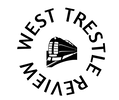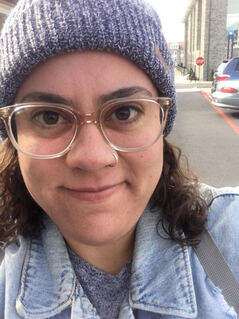Shifting Traditional Norms: An Interview with Artist, Kristin LaFollette
WTR is delighted to feature multimedia artist Kristin LaFollette in our November / December issue. In her interview with Olivia Joyce, LaFollette shares her inspiration, including her new home, music, medicine, Dada and surrealism.
OJ: Hi Kristin. Thank you so much for doing this interview with me! I really enjoyed the artwork you submitted to West Trestle Review, especially the two photo collages, No Parking, Part 1 and No Parking, Part 2. I would love to know what inspired you to create these pieces, and what was significant to you about the locations you portray in these two images?
KL: Thank you! My photography often finds its way into my artwork. After living for several years in Toledo, Ohio, I recently moved to southern Indiana for my job. I live in an historic neighborhood downtown and have loved being able to explore the area, look at the beautiful homes, meet the neighbors, and take photographs. After a day of shooting, I decided to create these photo collages and the “no parking” images stood out to me. No Parking, Part 1 showcases some of the brick architecture (the images in the collage are of the back of an apartment building, a garage, and the foundation of a church) while the images in No Parking, Part 2 are mostly of fences lining an alleyway behind some historic homes and businesses. I attempted to show the still up-and-coming nature of the downtown area through the tearing and layering of the individual photographs in each collage. Living in a new place is exciting and anxiety-inducing at the same time, so shooting these photographs and creating these collages provided me with opportunities to learn more about the city.
OJ: What is your process when you create acrylic pieces, such as the ones published in West Trestle Review?
KL: I definitely find inspiration in music. Whenever I get ready to start a new painting, I have a vague idea of what I want to create, but it’s usually not a fully formed idea. Instead, I like to listen to music and let it guide my art-making process. My choice of music varies from day to day, but some recent favorites include The Lumineers, Death Cab for Cutie, Bon Iver, Fleet Foxes, and Lord Huron. The two acrylic paintings in West Trestle are named after songs/lyrics from The Lumineers’ Cleopatra album. Songs tell stories, and I attempt to capture those stories in my paintings.
OJ: From your website, I found that you studied medicine and worked in a hospital before following a different path, and that what you learned has shaped your work in the humanities. How does your knowledge of medicine inform not only your art, but also your research and studies?
KL: Yes, I did study medicine for several years after working in various hospital and clinical settings! Even though I don’t work in the medical field anymore (I’m actually a professor in the humanities), I still have an obsession with medicine and anatomy. Anatomical diagrams and images frequently find their way into my poetry and artwork, and medicine has become a more integral component of my agenda as a researcher in the humanities. I study rhetoric (which focuses on how we communicate) and there is a growing subfield known as the rhetoric of health and medicine or RHM (which deals with communicative practices related to health and medicine). I recently received a grant from my university for a research project focused on an arts-based pedagogical approach through an RHM lens and that project is currently being revised for publication.
OJ: Much of your artwork appears to be collage, which is a form of art we have included quite a bit in WTR. What about collaging appeals to you as an artist?
KL: I love the Dada and Surrealist art movements and the collage form (as a combination of image, text, and other materials) developed out of those movements. Dada and Surrealist artists were all about challenging viewers’ perceptions, shifting traditional norms surrounding who could be an artist and what could be considered art, and creating interesting tensions between image and text. I create collage work with these concepts in mind. I often use my own photography and poetry and, in the process, hope to create new meaning that wouldn’t be possible without the image(s) and text existing together in the same composition.
OJ: Lately, with the pandemic, elections, and numerous protests throughout the country, most people have undergone drastic changes within the last year. Do you feel that your art has evolved and changed as a result of the different world we currently live in, or has it remained a constant throughout this time?
KL: I don’t think my style or approach has changed, but the time I devote to creating art has definitely increased. It has certainly been a tumultuous year, and I find writing and art-making to be very therapeutic. Whenever I’m feeling stressed or overwhelmed, I love being able to hide out in my studio and write or create art for hours. For years, support and funding for the arts and humanities have diminished. However, I’ve noticed that creating and consuming art has been an extremely popular approach for coping with the chaos we’ve all experienced this year, and I think this is a great reminder to everyone that the arts and humanities have immense value to unite us and bring a sense of hope and positivity to our lives.
OJ: Thank you so much for your time, Kristin!
KL: Thank you! My photography often finds its way into my artwork. After living for several years in Toledo, Ohio, I recently moved to southern Indiana for my job. I live in an historic neighborhood downtown and have loved being able to explore the area, look at the beautiful homes, meet the neighbors, and take photographs. After a day of shooting, I decided to create these photo collages and the “no parking” images stood out to me. No Parking, Part 1 showcases some of the brick architecture (the images in the collage are of the back of an apartment building, a garage, and the foundation of a church) while the images in No Parking, Part 2 are mostly of fences lining an alleyway behind some historic homes and businesses. I attempted to show the still up-and-coming nature of the downtown area through the tearing and layering of the individual photographs in each collage. Living in a new place is exciting and anxiety-inducing at the same time, so shooting these photographs and creating these collages provided me with opportunities to learn more about the city.
OJ: What is your process when you create acrylic pieces, such as the ones published in West Trestle Review?
KL: I definitely find inspiration in music. Whenever I get ready to start a new painting, I have a vague idea of what I want to create, but it’s usually not a fully formed idea. Instead, I like to listen to music and let it guide my art-making process. My choice of music varies from day to day, but some recent favorites include The Lumineers, Death Cab for Cutie, Bon Iver, Fleet Foxes, and Lord Huron. The two acrylic paintings in West Trestle are named after songs/lyrics from The Lumineers’ Cleopatra album. Songs tell stories, and I attempt to capture those stories in my paintings.
OJ: From your website, I found that you studied medicine and worked in a hospital before following a different path, and that what you learned has shaped your work in the humanities. How does your knowledge of medicine inform not only your art, but also your research and studies?
KL: Yes, I did study medicine for several years after working in various hospital and clinical settings! Even though I don’t work in the medical field anymore (I’m actually a professor in the humanities), I still have an obsession with medicine and anatomy. Anatomical diagrams and images frequently find their way into my poetry and artwork, and medicine has become a more integral component of my agenda as a researcher in the humanities. I study rhetoric (which focuses on how we communicate) and there is a growing subfield known as the rhetoric of health and medicine or RHM (which deals with communicative practices related to health and medicine). I recently received a grant from my university for a research project focused on an arts-based pedagogical approach through an RHM lens and that project is currently being revised for publication.
OJ: Much of your artwork appears to be collage, which is a form of art we have included quite a bit in WTR. What about collaging appeals to you as an artist?
KL: I love the Dada and Surrealist art movements and the collage form (as a combination of image, text, and other materials) developed out of those movements. Dada and Surrealist artists were all about challenging viewers’ perceptions, shifting traditional norms surrounding who could be an artist and what could be considered art, and creating interesting tensions between image and text. I create collage work with these concepts in mind. I often use my own photography and poetry and, in the process, hope to create new meaning that wouldn’t be possible without the image(s) and text existing together in the same composition.
OJ: Lately, with the pandemic, elections, and numerous protests throughout the country, most people have undergone drastic changes within the last year. Do you feel that your art has evolved and changed as a result of the different world we currently live in, or has it remained a constant throughout this time?
KL: I don’t think my style or approach has changed, but the time I devote to creating art has definitely increased. It has certainly been a tumultuous year, and I find writing and art-making to be very therapeutic. Whenever I’m feeling stressed or overwhelmed, I love being able to hide out in my studio and write or create art for hours. For years, support and funding for the arts and humanities have diminished. However, I’ve noticed that creating and consuming art has been an extremely popular approach for coping with the chaos we’ve all experienced this year, and I think this is a great reminder to everyone that the arts and humanities have immense value to unite us and bring a sense of hope and positivity to our lives.
OJ: Thank you so much for your time, Kristin!
Kristin LaFollette is a writer, artist, and photographer and is the author of the chapbook, Body Parts (GFT Press, 2018). She is a professor at the University of Southern Indiana and serves as the Art Editor at Mud Season Review. You can visit her on Twitter at @k_lafollette03
Art: October, 2006 by Kristin LaFollette
Powered by Women

